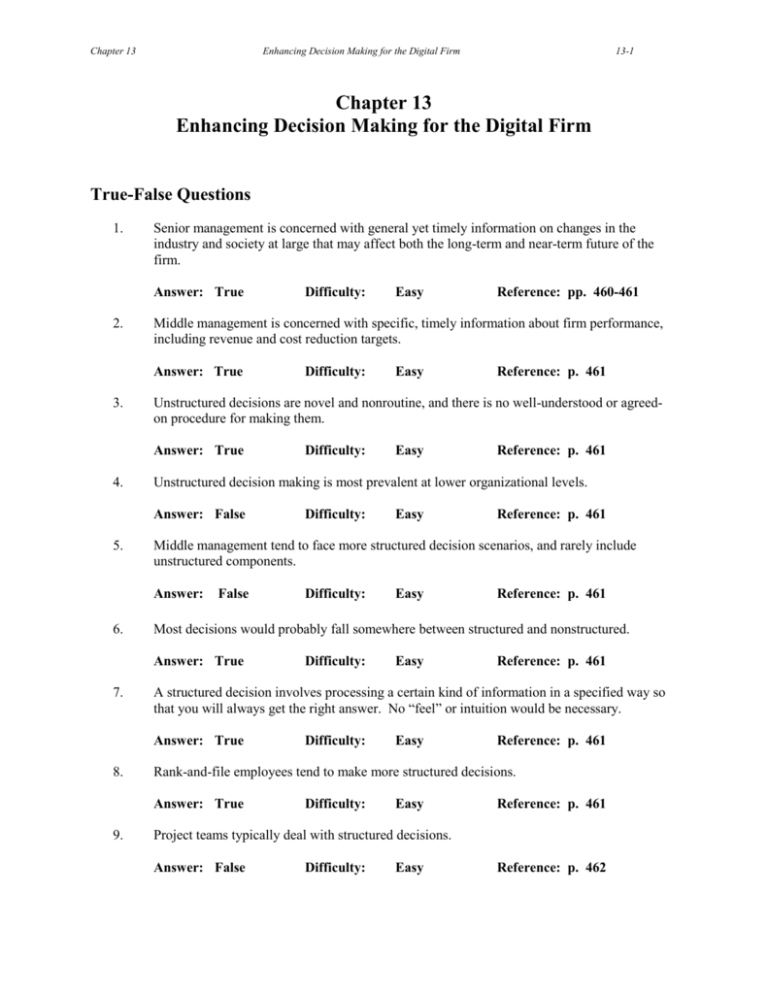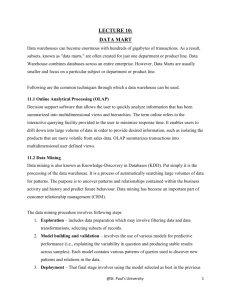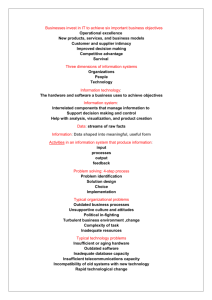Chapter 13: Enhancing Decision Making for the Digital Firm
advertisement

Chapter 13 Enhancing Decision Making for the Digital Firm 13-1 Chapter 13 Enhancing Decision Making for the Digital Firm True-False Questions 1. Senior management is concerned with general yet timely information on changes in the industry and society at large that may affect both the long-term and near-term future of the firm. Answer: True 2. False Easy Reference: p. 461 Difficulty: Easy Reference: p. 461 Difficulty: Easy Reference: p. 461 Difficulty: Easy Reference: p. 461 Difficulty: Easy Reference: p. 461 Rank-and-file employees tend to make more structured decisions. Answer: True 9. Difficulty: A structured decision involves processing a certain kind of information in a specified way so that you will always get the right answer. No “feel” or intuition would be necessary. Answer: True 8. Reference: p. 461 Most decisions would probably fall somewhere between structured and nonstructured. Answer: True 7. Easy Middle management tend to face more structured decision scenarios, and rarely include unstructured components. Answer: 6. Difficulty: Unstructured decision making is most prevalent at lower organizational levels. Answer: False 5. Reference: pp. 460-461 Unstructured decisions are novel and nonroutine, and there is no well-understood or agreedon procedure for making them. Answer: True 4. Easy Middle management is concerned with specific, timely information about firm performance, including revenue and cost reduction targets. Answer: True 3. Difficulty: Difficulty: Easy Reference: p. 461 Project teams typically deal with structured decisions. Answer: False Difficulty: Easy Reference: p. 462 13-2 Enhancing Decision Making for the Digital Firm 10. The intelligence phase of decision making finds or recognizes a problem, need, or opportunity. Answer: True 11. Reference: p. 462 Difficulty: Easy Reference: p. 462 Difficulty: Easy Reference: p. 462 Difficulty: Easy Reference: p. 462 Difficulty: Easy Reference: p. 463 Difficulty: Easy Reference: p. 465 Difficulty: Easy Reference: p. 466 Medium Reference: p. 466 The earliest DSS were not model-driven. Answer: False 20. Medium DSS primarily address structured problems. Answer: False 19. Difficulty: MIS typically produce fixed, regularly scheduled reports based on data extracted and summarized from the firm’s underlying transaction processing systems. Answer: True 18. Reference: p. 462 In the real world, Simon’s decision-making phases would follow a linear path. Answer: False 17. Easy The design phase of Simon’s decision-making process involves identifying and exploring various solutions to the problem. Answer: True 16. Difficulty: The first stage in Simon's decision-making process model is the choice stage. Answer: False 15. Reference: p. 462 Executive support systems are targeted systems that combine analytical models with operational data and supportive interactive queries and analysis. Answer: False 14. Easy Management information systems provide routine reports and summaries of transactionslevel data to middle and operational-level managers to provide answers to structured and semistructured decision problems. Answer: True 13. Difficulty: The choice phase of decision making considers ways to solve problems, fill needs, or take advantage of opportunities. Answer: False 12. Chapter 13 Difficulty: With query-oriented data analysis, users need to know what they’re looking for. Answer: True Difficulty: Medium Reference: p. 466 Chapter 13 21. Enhancing Decision Making for the Digital Firm Data mining does not use fuzzy logic. Answer: False 22. Reference: p. 470 Difficulty: Easy Reference: p. 470 Difficulty: Easy Reference: p. 470 Difficulty: Easy Reference: p. 472 Difficulty: Easy Reference: p. 473 Difficulty: Easy Reference: p. 473 Difficulty: Easy Reference: p. 473 Web-based tools for videoconferencing and electronic meetings are the primary tools for GDSS. Answer: False 31. Easy DSS are a special category of GIS. Answer: False 30. Difficulty: A geographic information system is a decision support system designed specifically to work with spatial information. Answer: True 29. Reference: p. 470 Data visualization technologies can make it more difficult for users to understand the data from information systems. Answer: False 28. Medium Predictive analysis uses data-mining techniques, historical data, and assumptions about future conditions to predict outcomes of events. Answer: True 27. Difficulty: The user interface for a DSS must be relatively intuitive, because it may be used by managers or employees with no patience to learn a complex tool. Answer: True 26. Reference: p. 467 Backward sensitivity analysis software is used for goal seeking. Answer: True 25. Medium What-if analysis works forward from known or assumed conditions. Answer: True 24. Difficulty: Forecasting models cannot be used to predict the actions of competitors. Answer: False 23. 13-3 Difficulty: Hard Reference: p. 476 During a GDSS electronic meeting, the attendees control the use of GDSS tools. Answer: False Difficulty: Easy Reference: p. 477 13-4 Enhancing Decision Making for the Digital Firm 32. GDSS outcomes are always better than face-to-face meetings. Answer: False 33. Difficulty: Medium Reference: p. 479 Difficulty: Easy Reference: p. 479 Difficulty: Easy Reference: p. 480 Difficulty: Easy Reference: p. 481 Difficulty: Easy Reference: p. 482 The use of critical success factors and other information requirements determination methods does not always help establish information requirements for ESS and DSS serving senior management. Answer: True 40. Reference: p. 479 Enterprise reporting capabilities create measures of firm performance that were not previously available. Answer: True 39. Easy Balanced scorecard systems show how well the firm is meeting its strategic goals. Answer: True 38. Difficulty: An advantage of ESS is the ability to identify opportunities early on. Answer: True 37. Reference: p. 478 Contemporary ESS need to have some facility for environmental scanning. Answer: True 36. Easy Contemporary ESS do not need tools for modeling and analysis. Answer: False 35. Difficulty: Integrating data from systems designed for very different purposes is a challenge of building ESS. Answer: True 34. Chapter 13 Difficulty: Easy Reference: p. 483 The business value of DSS and ESS does not depend on changing patterns of management decision making. Answer: False Difficulty: Medium Reference: p. 483 Chapter 13 Enhancing Decision Making for the Digital Firm 13-5 Multiple-Choice Questions 41. Applications and technologies that work with data from many different sources to help users make better business decisions are referred to as: a. b. c. d. data libraries. enterprise reporting. operational planning. business intelligence. Answer: 42. Easy Reference: p. 458 senior middle operational knowledge Answer: b Difficulty: Easy Reference: p. 461 This management level is in charge of specific projects and allocate resources within the project budget: a. b. c. d. senior. middle. operational. knowledge. Answer: 44. Difficulty: Allocating resources, developing short-range plans, and monitoring the performance of departments is the concern of this level of management: a. b. c. d. 43. d c Difficulty: Medium Reference: p. 461 Where there is no well-understood or agreed-on procedure for making a decision, it is said to be: a. b. c. d. roundabout. unstructured. structured. semistructured. Answer: b Difficulty: Easy Reference: p. 461 13-6 Enhancing Decision Making for the Digital Firm 45. Decision makers can follow a definite procedure for making a decision, it is said to be a(n): a. b. c. d. structured decision. unstructured decision. semistructured decision. obscure decision. Answer: 46. Easy Reference: p. 461 c Difficulty: Easy Reference: p. 461 These types of decisions are most common at higher levels of management: a. b. c. d. disguised decisions. unstructured decisions. structured decisions. semistructured decisions. Answer: b Difficulty: Easy Reference: p. 461 Rank-and-file employees tend to make more of these types of decisions: a. b. c. d. semistructured unstructured structured disguised Answer: 49. Difficulty: indirect decisions. unstructured decisions. structured decisions. semistructured decisions. Answer: 48. a These types of decisions are more prevalent at lower organizational levels: a. b. c. d. 47. Chapter 13 c Difficulty: Easy Reference: p. 462 Which phase of decision making finds or recognizes a problem, need, or opportunity? a. Design b. Intelligence c. Choice d. Implementation Answer: b Difficulty: Easy Reference: p. 462 Chapter 13 50. Enhancing Decision Making for the Digital Firm Which type of decision is calculating gross pay for hourly workers? a. b. c. d. Structured decision Nonstructured decision Recurring decision Nonrecurring decision Answer: 51. a Difficulty: Easy Reference: p. 462 Which type of decision is deciding whether to introduce a new product line? a. b. c. d. Structured decision. Nonstructured decision. Recurring decision. Nonrecurring decision. Answer: 52. 13-7 b Difficulty: Easy Reference: p. 462 MIS typically produce: a. new ways of looking at data that emphasize change, flexibility, and rapid response. b. fixed, regularly scheduled reports based on data extracted from the organization’s TPS. c. solutions to semistructured problems appropriate for middle management decisionmaking. d. assumptions, responses to ad hoc queries, and graphic representations of existing data. Answer: 53. Difficulty: Easy Reference: p. 462 DSS are intended to help design and evaluate alternatives and: a. b. c. d. monitor the adoption or implementation process. provide reports through an intranet. provide information to business partners. monitor and forecast the business decisions taken by senior managers. Answer: 54. b a Difficulty: Medium Reference: p. 462 Simon’s description of decision-making consists of four stages: a. b. c. d. planning, financing, implementation, and maintenance. planning, design, implementation, and maintenance. intelligence, design, choice, and implementation. intelligence, design, financing, and implementation. Answer: c Difficulty: Medium Reference: p. 462 13-8 Enhancing Decision Making for the Digital Firm 55. Simon’s description of decision-making consists of four stages. This stage consists of discovering, identifying, and understanding the problem: a. b. c. d. intelligence. design. choice. implementation. Answer: 56. Medium Reference: p. 462 a Difficulty: Easy Reference: p. 465 These systems are intended to help design and evaluate alternatives and monitor the adoption or implementation process: a. b. c. d. GPS ESS TPS DSS Answer: d Difficulty: Easy Reference: p. 465 Medium Reference: p. 466 Model-driven DSS:: a. b. c. d. analyze large pools of data. are primarily standalone systems. use multidimensional analysis. mine Web site data. Answer: 59. Difficulty: MIS. DSS. ESS. GDSS. Answer: 58. a This application typically produces fixed, regularly scheduled reports based on data extracted and summarized from the organization’s TPS: a. b. c. d. 57. Chapter 13 b Difficulty: ___________________ provides insights into corporate data that cannot be obtained with OLAP by finding hidden patterns and rules used to guide decision making and forecast the effect of those decisions. a. b. c. d. Association Sequencing Profitability analysis Data mining Answer: d Difficulty: Easy Reference: p. 466 Chapter 13 60. Enhancing Decision Making for the Digital Firm In data mining, occurrences linked to a single event are called: a. b. c. d. associations. sequences. classifications clusters. Answer: 61. Hard Reference: p. 467 d Difficulty: Easy Reference: p. 467 Medium Reference: p. 469 Optimization models often use: a. b. c. d. data co-integration. linear programming. abstract decision processing. model data libraries. Answer: b Difficulty: The components of the DSS are the: a. b. c. d. internal database, external database, and analysis tools. data visualization tools, software, and graphics capabilities. database, graphics capabilities, and analysis tools. database, software system, and user interface. Answer: 64. Difficulty: Sequencing Association Profitability analysis Forecasting Answer: 63. a _________________ helps managers estimate the future value of continuous variables such as sales figures. a. b. c. d. 62. 13-9 d Difficulty: Easy Reference: p. 469 A model that asks what-if questions repeatedly to determine the impact on outcomes of changes in one or more factors is called a(n): a. b. c. d. optimization model. sensitivity analysis model. goal seeking model. slice and dice model. Answer: b Difficulty: Easy Reference: p. 470 13-10 65. Enhancing Decision Making for the Digital Firm Backward sensitivity analysis software is used for: a. b. c. d. sequencing. what-if. goal seeking. slice and dice. Answer: 66. Easy Reference: p. 470 a Difficulty: Hard Reference: p. 471 A model that uses data-mining techniques, historical data, and assumptions about future conditions to predict outcomes of events is known as: a. b. c. d. optimization analysis. sensitivity analysis. predictive analysis. goal seeking analysis. Answer: c Difficulty: Easy Reference: p. 472 This information system uses data visualization technology to analyze and display data for planning and decision making in the form of digitized maps: a. b. c. d. GIS. DSS. MIS. TPS. Answer: 69. Difficulty: optimization. goal seeking. what-if sensitivity. Answer: 68. c Discount chain ShopKo Stores uses this type of software to determine the optimal time and price for marking down items: a. b. c. d. 67. Chapter 13 a Difficulty: Easy Reference: p. 473 Electronic questionnaires in a GDSS: a. facilitate the organized integration and synthesis of ideas generated during brainstorming. b. document group agreement on definitions of words and terms central to the projects. c. use structured approaches to evaluate the impact of an emerging proposal on the organization. d. aid the organizers in premeeting planning by identifying issues of concern. Answer: d Difficulty: Easy Reference: p. 477 Chapter 13 70. Enhancing Decision Making for the Digital Firm 13-11 Idea organizers in a GDSS: a. facilitate the organized integration and synthesis of ideas generated during brainstorming. b. document group agreement on definitions of words and terms central to the projects. c. use structured approaches to evaluate the impact of an emerging proposal on the organization. d. aid the organizers in premeeting planning by identifying issues of concern. Answer: 71. a Difficulty: Easy Reference: p. 477 Tools for voting or setting priorities in a GDSS: a. facilitate the organized integration and synthesis of ideas generated during brainstorming. b. document group agreement on definitions of words and terms central to the projects. c. use structured approaches to evaluate the impact of an emerging proposal on the organization. d. make available a range of methods for setting priorities. Answer: 72. d Difficulty: Easy Reference: p. 477 Policy formation tools in a GDSS: a. facilitate the organized integration and synthesis of ideas generated during brainstorming. b. provide structured support for developing agreement on the wording of guideline statements. c. use structured approaches to evaluate the impact of an emerging proposal on the organization. d. aid the organizers in premeeting planning by identifying issues of concern. Answer: 73. b Difficulty: Easy Reference: p. 477 Stakeholder identification and analysis tools in a GDSS: a. facilitate the organized integration and synthesis of ideas generated during brainstorming. b. document group agreement on definitions of words and terms central to the projects. c. use structured approaches to evaluate the impact of an emerging proposal on the organization. d. aid the organizers in premeeting planning by identifying issues of concern. Answer: c Difficulty: Easy Reference: p. 477 13-12 74. Enhancing Decision Making for the Digital Firm Chapter 13 In an electronic meeting system, group interaction includes: a. session planning, organizational memory, personal productivity, and enterprise analysis. b. idea generation, complex problems, and large groups. c. idea generation, idea organization, prioritizing, and policy development. d. session planning, prioritizing, policy development and organizational memory. Answer: 75. c Difficulty: Hard Reference: p. 478 GDSS are most useful for tasks involving: a. session planning, organizational memory, personal productivity, and enterprise analysis. b. idea generation, complex problems, and large groups. c. idea generation, idea organization, prioritizing, and policy development. d. session planning, prioritizing, policy development, and organizational memory. Answer: 76. Medium Reference: p. 479 Reference: p. 479 data overload. spotting problems. data manipulation. their inability to monitor organizational performance. Answer: a Difficulty: Easy Executives need a wide range of __________________ as well as internal data. a. b. c. d. executive support systems training in using ESS system functionality external Answer: 78. Difficulty: A problem common to paper reports is: a. b. c. d. 77. b d Difficulty: Easy Reference: p. 479 Reference: p. 480 The easy use of graphics in an ESS allows the user to: a. b. c. d. look at more data in less time with greater clarity. use creative analysis. examine other managers’ work without their knowledge. decentralize decision making. Answer: a Difficulty: Easy Chapter 13 79. Enhancing Decision Making for the Digital Firm The traditional measurement of value for companies includes financial metrics such as: a. b. c. d. double-entry bookkeeping. ING metrics analysis. balanced scorecards. return on investment. Answer: 80. 13-13 d Difficulty: Easy Reference: p. 481 Even if a problem can be addressed by an information system, senior management: a. b. c. d. may not be able to use one. may not have a complete data warehouse. may not be able to read the reports generated. may not fully understand its actual information needs. Answer: d Difficulty: Medium Reference: p. 483 Fill In the Blanks 81. The term business intelligence refers to applications and technologies that work with data from many different sources to help users make better business decisions. Difficulty: Easy 82. p. 461 Reference: p. 461 Simon’s description of decision making consists of four stages: intelligence, design, choice, and implementation. Difficulty: Easy 85. Reference: A(n) unstructured decision is novel and nonroutine. Difficulty: Easy 84. p. 458 A(n) structured decision is repetitive and routine, for which known algorithms provide solutions. Difficulty: Easy 83. Reference: Reference: pp. 462-463 An MIS typically produces fixed, regularly scheduled reports based on data from the company’s transaction processing system. Difficulty: Hard Reference: p. 465 13-14 86. Enhancing Decision Making for the Digital Firm A(n) model-driven DSS is primarily a stand-alone system using some type of pattern to perform “what-if” and other kinds of analyses. Difficulty: Easy 87. Reference: p. 467 Reference: p. 467 Reference: p. 467 Reference: p. 467 Reference: p. 469 In a DSS, the DSS database is a collection of current or historical data from a number of applications or groups. Difficulty: Easy 96. p. 467 Forecasting uses a series of existing values to predict what other values will be. Difficulty: Medium 95. Reference: Knowledge discovery is the process of identifying novel and valuable patterns in large volumes of data. Difficulty: Medium 94. p. 466 Clustering discovers different groupings within data, such as finding affinity groups for bank cards or partitioning a database into groups of customers based on demographics and types of personal investments. Difficulty: Medium 93. Reference: Classification recognizes patterns describing the group to which an item belongs by examining existing items that have been classified and by inferring a set of rules. Difficulty: Medium 92. p. 466 Sequences are events linked over time. Difficulty: Medium 91. Reference: Associations are occurrences linked to a single event. Difficulty: Medium 90. p. 466 Data mining is more discovery driven than traditional database queries. Difficulty: Medium 89. Reference: A(n) data-driven DSS supports decision making by allowing users to extract and analyze useful information previously buried in large groupings. Difficulty: Easy 88. Chapter 13 Reference: p. 469 In a DSS, the DSS software system is a collection of software tools used for data analysis. Difficulty: Easy Reference: p. 469 Chapter 13 97. Enhancing Decision Making for the Digital Firm A(n) model is an abstract representation illustrating the components or relationships of a phenomenon. Difficulty: Easy 98. Reference: p. 469 A(n) optimization model determines the best resource allocation to maximize or minimize specified variables. Difficulty: Medium 99. 13-15 Reference: p. 469 A(n) sensitivity analysis is a model that asks “what-if” questions repeatedly, changing certain values each time. Difficulty: Medium Reference: p. 470 100. A(n) what-if analysis works forward from known or assumed conditions to test the impact on outcomes of changes in the values of specified variables. Difficulty: Medium Reference: p. 470 101. A(n) backward sensitivity analysis is used for goal seeking. Difficulty: Hard Reference: p. 470 102. Parkway Corporation’s asset utilization system is an example of a data-driven DSS. Difficulty: Hard Reference: p. 472 103. Predictive analysis uses data-mining techniques, historical data, and assumptions about future conditions to predict outcomes of events. Difficulty: Medium Reference: p. 472 104. Data visualization helps users see patterns and relationships in large amounts of data by presenting the data in graphical form. Difficulty: Medium Reference: p. 473 105. A(n) geographic information system (GIS) analyzes and displays data using digitized maps to enhance planning and decision making. Difficulty: Easy Reference: p. 473 106. Web-based DSS have become very popular in the financial services area because so many people are trying to manage their own assets and savings. Difficulty: Medium Reference: p. 473 13-16 Enhancing Decision Making for the Digital Firm Chapter 13 107. A(n) customer decision-support system (CDSS) supports the decision-making processes of an existing or potential customer. Difficulty: Easy Reference: p. 474 108. A(n) customer decision-support system (CDSS) helps the customer decide what products to buy. Difficulty: Easy Reference: p. 474 109. A(n) group decision-support system (GDSS) facilitates the solution to unstructured problems by a set of decision-makers working together as a group. Difficulty: Easy Reference: p. 476 110. A(n) group decision-support system (GDSS) is an interactive computer-based system to facilitate the solution to unstructured problems by a set of decision makers working together as a group. Difficulty: Easy Reference: p. 477 111. In a collaboration laboratory, individuals work on their own desktop PCs or workstations. Difficulty: Medium Reference: p. 477 112. A(n) facilitator controls the use of the GDSS tools during an electronic meeting, but each attendee controls his/her own screen. Difficulty: Easy Reference: p. 477 113. Drilling down is the ability to move from summary data to lower and lower levels of detail. Difficulty: Easy Reference: p. 479 114. Contemporary ESS include tools for modeling and analysis. Difficulty: Easy Reference: p. 479 115. In an ESS, the easy use of graphics allows the user to look at more data in less time with greater clarity than paper-based systems provide. Difficulty: Easy Reference: p. 480 116. The most visible benefit of ESS is their ability to analyze trends. Difficulty: Medium Reference: p. 480 Chapter 13 Enhancing Decision Making for the Digital Firm 13-17 117. Digital dashboards use easy-to-understand displays to provide management with a comprehensive view of firm performance on a single screen. Difficulty: Hard Reference: p. 481 118. A(n) balanced scorecard is a model for analyzing firm performance that supplements traditional financial measures with measurements from additional business perspectives. Difficulty: Easy Reference: p. 481 119. Activity-based costing is a model for identifying all the company processes that cause expenses to occur while producing a specific product or service. Difficulty: Hard Reference: p. 482 120. Activity-based costing is a model for identifying unprofitable products and services. Difficulty: Medium Reference: p. 482 Essay Questions 121. Your text states that many t managers use the new capabilities in DSS and ESS to obtain the same information as before the new systems were implemented. . How would you induce a traditional manager to use new DSS and ESS more effectively? Managers must be trained to ask better questions of the data. This will require major changes in traditional management thinking. Perhaps one way to induce a traditional manager to be more interested in these systems would be a dog-and-pony show at a senior-level management retreat. Of course, the introduction into mid-level management of people trained in the use of these systems could also act as a spur. 13-18 122. Enhancing Decision Making for the Digital Firm Chapter 13 Describe the two types of DSS. Explain circumstances in which one might be used. Give an example of the use of each system. Model-driven DSS were primarily stand-alone systems isolated from major organizational information systems that used some type of model to perform “what-if” and other types of analyses. Their analysis capabilities were based on a strong theory or model combined with a good user interface to make the model easy to use. There are several examples in the textbook: the voyage-estimating DSS described in chapter 2, the Gaps planning and forecasting system described at the beginning of this chapter, and Continental Airlines system for cargo revenue optimization are mentioned on page 350. The second type of DSS is a data-driven DSS. These systems analyze large pools of data found in major organizational systems. They support decision making by allowing users to extract useful information that was previously buried in large quantities of data. Often data from transaction processing systems are collected in data warehouses for this purpose. OLAP and data mining can then be used to analyze the data. WH Smith PLC’s system for online sales and profitability analysis described in the Window on Organizations, p. 352, is an example of a data-driven DSS. 123. Describe/Define at least four types of information that datamining can yield. Give an example of each one. There are five types of information discussed in the text: Associations – are occurrences linked to a single event. Example: A study of supermarket purchasing patterns might reveal that when corn chips are purchased, a cola drink is purchased 65 percent of the time, but when there is a promotion, cola is purchased 85 percent of the time. Sequences – events are linked over time. Example: If a house is purchased, a new refrigerator will be purchased within two weeks 65 percent of the time, and an oven will be bought within one month of the home purchase 45 percent of the time. Classifications – recognizes patterns that describe the group to which an item belongs by examining existing items that have been classified and by inferring a set of rules. Example: Businesses such as credit card or telephone companies worry about the loss of steady customers. Classification can help discover the characteristics of customers who are likely to leave and can provide a model to help managers predict who they are so that they can devise special campaigns to retain such customers. Clusters – working in a manner similar to classification when no groups have yet been defined. Example: A data-mining tool can discover different groupings within data, such as finding affinity groups for bank cards or partitioning a database into groups of customers based on demographics and types of personal investments. Forecasts – uses a series of existing values to forecast what other values will be. Example: Forecasting might find patterns in data to help managers estimate the future value of continuous variables such as sales figures. Chapter 13 124. Enhancing Decision Making for the Digital Firm 13-19 Discuss the four types of models commonly found in model libraries. Statistical modeling software can be used to help establish relationships, such as relating product sales to differences in age, income, or other factors between communities. Optimization models, often using linear programming, determined optimal resource allocation to maximize or minimize specified variables such as cost or time. A classic use of optimization models is to determine the proper mix of products within a given market to maximize profits. Forecasting models are often used to forecast sales. The user of this type of model might supply a range of historical data to project future conditions and the sales that might result from those conditions. Companies often use this software to predict the actions of competitors. Sensitivity analysis models ask “what-if” questions repeatedly to determine the impact of changes in one or more factors on outcomes. 125. How specifically does the digital firm use DSS? Discuss each use, giving examples. DSS can help companies improve supply chain management and customer relationship management. Some take advantage of the company-wide data provided by enterprise systems. DSS today can also harness the interactive capabilities of the Web to provide decision-support tools to both employees and customers. 126. List and describe at least three ways in which GIS can be used by modern business. Geographic information systems are a special category of DSS that use data visualization technology to analyze and display data for planning and decision-making in the form of digitized maps. GIS can best be used to support decisions that require knowledge about the geographic distribution of people or other resources in scientific research, resource management, and development planning. GIS have modeling capabilities, allowing managers to change data and automatically revise business scenarios to find better solutions. For instance, a company could display its customers on a map and then design the most efficient delivery route for its products. A second way in which it could be used would be to analyze demographic information to decide where to open branch restaurants. A third use could be customer demographic data and map information to locate people who are likely to become customers for the company’s services. 13-20 127. Enhancing Decision Making for the Digital Firm Chapter 13 Describe and explain how a GDSS works to enhance group decision making. What are at least four factors involved in the successful outcome of any group meeting? Beyond three to five attendees the traditional meeting process breaks down. GDSS software tools contribute to a more collaborative atmosphere by guaranteeing contributors’ anonymity so that attendees can focus on evaluating the ideas themselves. The GDSS software tools follow structured methods for organizing and evaluating ideas and for preserving the results of meetings, allowing non-attendees to locate needed information after the meeting. The documentation of the meeting by one group at one site can also be used as input to another meeting on the same project at another site. If properly designed and supported, GDSS meetings can increase the number of ideas generated and the quality of decisions while producing the desired results in fewer meetings. The nature of electronic meeting technology is only one of a number of factors that affect meeting processes and output. The outcome of group meetings depends upon the composition of the group, the manner in which the problem is presented to the group, the facilitator’s effectiveness, the organization’s culture and environment, the quality of the planning, the cooperation of the attendees, and the appropriateness of tools selected for different types of meetings and decision problems. 128. List at least three factors to consider when planning an ESS. A major challenge of building executive support systems has been to integrate data from systems designed for very different purposes so that senior executives can review organizational performance from a firm-wide perspective. ESS must be designed so that high-level managers and others can use them without much training. One area that merits special attention is the determination of executive information requirements. ESS need to have some facility for environmental scanning. A key information requirement of managers at the strategic level is the capability to detect signals of problems in the organizational environment that indicate strategic threats and opportunities. The ESS need to be designed so that both external and internal sources of information can be used for environmental scanning purposes. Implementation of the DSS must be carefully managed to neutralize the opposition of managers at the lower levels of the organization, because DSS potentially could give top executives the ability to examine their work without their knowledge. 129. Describe MIS and DSS and differentiate between them. MIS provide information on the firm’s performance to help managers monitor and control the business. They typically produce hard copy, fixed, regularly scheduled reports based on data extracted and summarized from the organization’s underlying transaction processing systems. DSS provide new sets of capabilities for nonroutine decisions and user control. MIS accents reports based on routine flows of data and assists in the general control of the organization. DSS emphasizes change, flexibility, and rapid response to unstructured problems. Chapter 13 130. Enhancing Decision Making for the Digital Firm 13-21 What is the balanced scorecard model? Why is it particularly useful? Where does it get its information? The balanced scorecard is a model for analyzing firm performance that supplements traditional financial measures with measurements from additional business perspectives, such as customers, internal business processes, and learning and growth. Managers can use balanced scorecard systems to see how well the firm is meeting its strategic goals. Data to fill out the scorecard, from sources such as financial ledger applications and client retention and market penetration ratios, feed a central data warehouse. The data is mined and ad hoc reports can be created.








